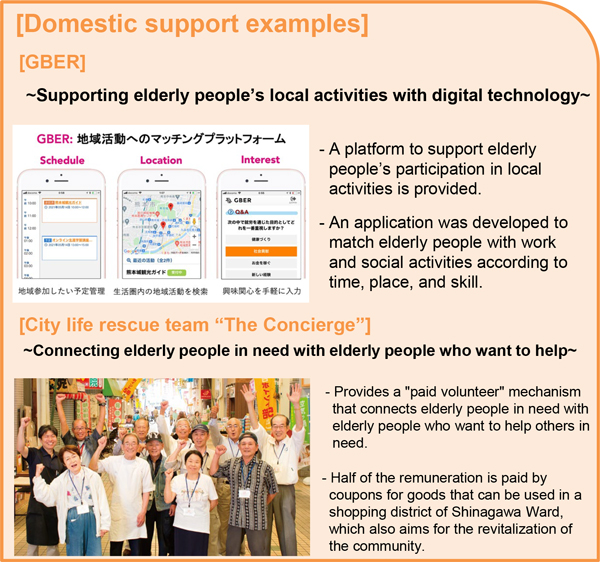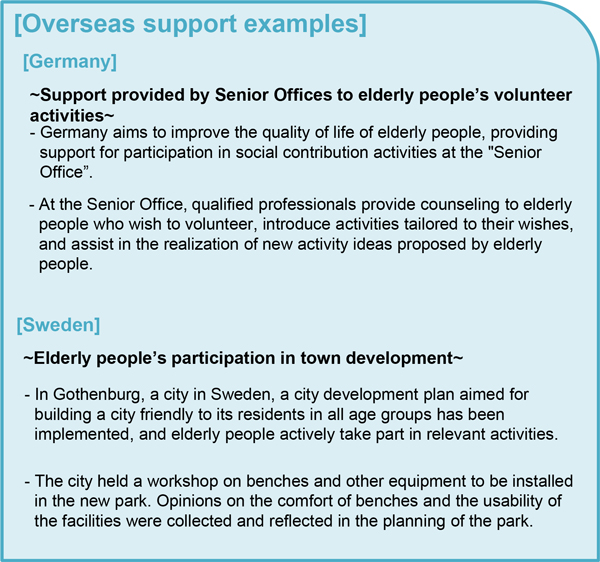[Feature] Consumption by elderly people and efforts toward the achievement of society with consumer citizenship
Part 1 : Trend in consumer issues and consumer attitude / behavior
Chapter 2 : [Feature] Consumption by elderly people and efforts toward the achievement of society with consumer citizenship
[Feature] Consumption by elderly people and efforts toward the achievement of society with consumer citizenship
<Trends in elderly people's consumer affairs consultations>
- The number of consumer affairs consultations sought by elderly people (aged 65 years and over) is about 250,000 per year (about 30% of the total number of consultations).
- In terms of different sales / purchase patterns, the proportion of elderly people tends to be high in relation to "door-to-door purchases" and "door-to-door sales."
- By product / service type, "health food" is ranked high for elderly people as a whole. The rank of "services related to home repair" becomes higher as the age increases, and there are consultations regarding sales under the guise of inspection and repeated sales. Among elderly women aged 65-74 years, "cosmetics" is ranked high.
→Even among elderly people, there are different trends observed in consumer problems according to their age groups.
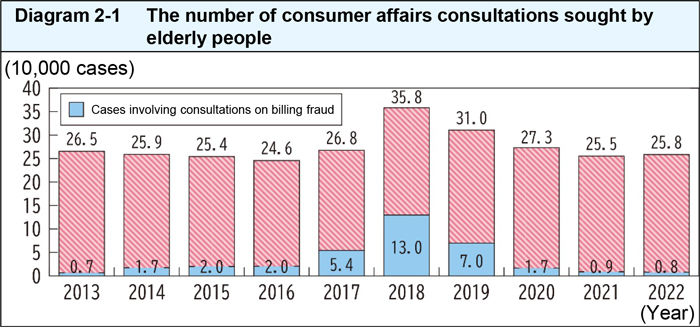
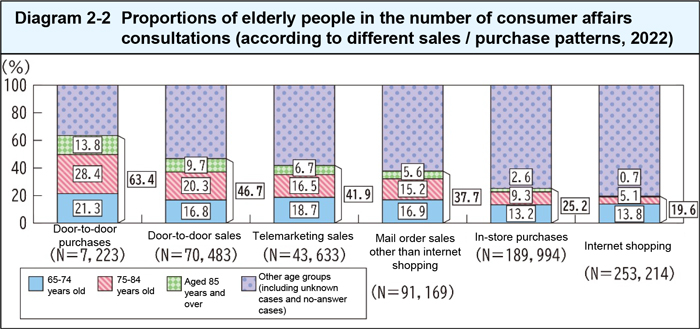
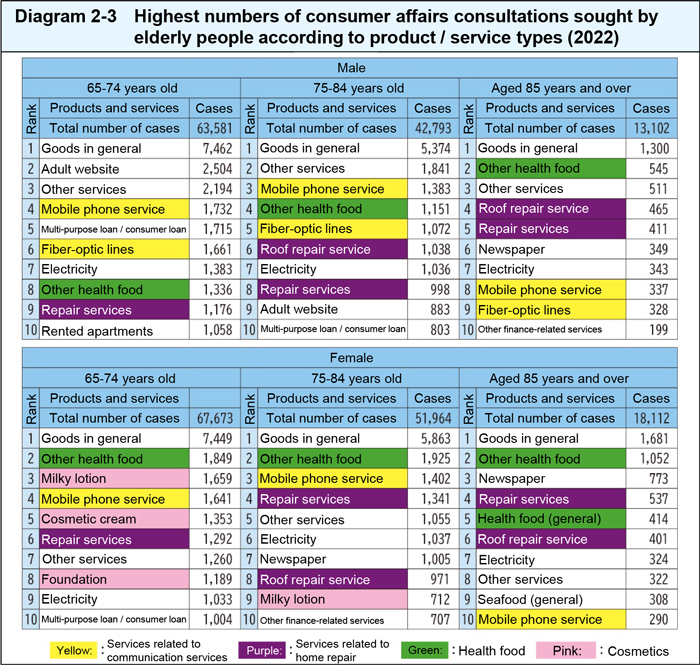
(Note) All the diagrams are created based on consumer affairs consultations registered with PIO-NET (as of March 31, 2023).
<Elderly people's problems related to internet shopping, etc.>
- Elderly people, especially those aged 75 years and over, use the Internet less frequently.
- The number of consultations on "internet shopping" sought by elderly people in 2022 marked the highest in the last few years, with those aged 65-74 years accounting for two-thirds.
- The number of consultations on "subscription" sought by elderly people reached a record-high level, with problems related to cosmetics and health food encountered mainly by those aged 65-74 years.
- In terms of different sales / purchase patterns, the proportion of internet shopping becomes lower as the age increases; it is only 5% among people aged 85 years and over while it is over one-fourth among people aged 65-74 years.
→There are differences between elderly people who use the Internet and those who use it infrequently, and measures and efforts need to be tailored to each trend.
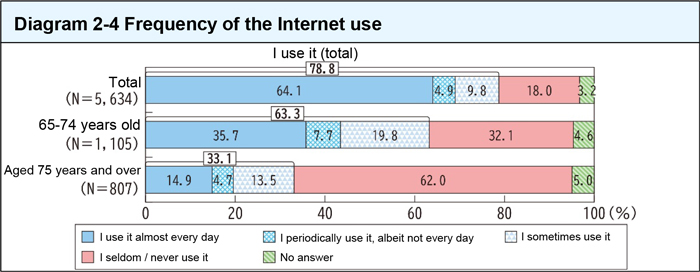
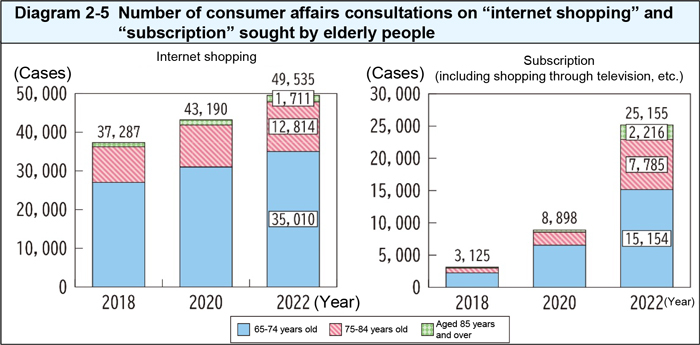
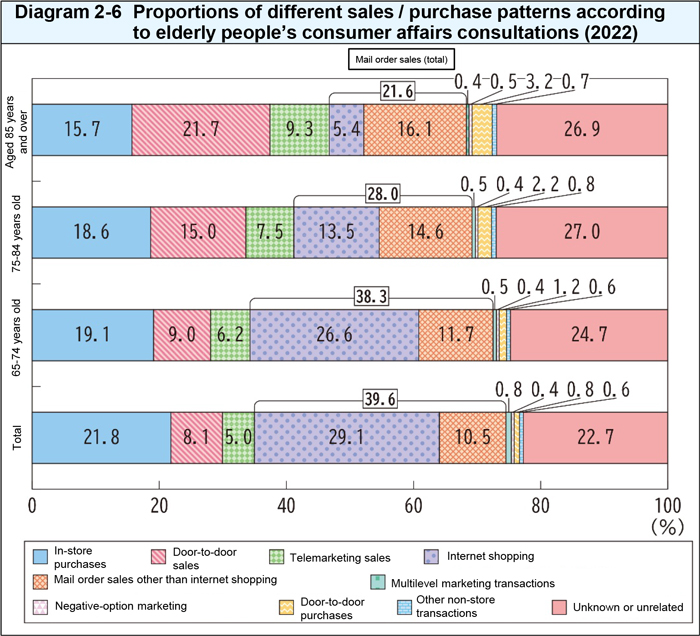
(Note) Diagram 2-4: created from the "Basic Survey on Consumer Life" (FY2022) of the Consumer Affairs Agency. Diagram 2-5, 2-6: created based on information on consumer affairs consultations registered with PIO-NET (as of March 31, 2023).
<Elderly people's awareness and experience of using internet shopping and their anxiety about health>
- The proportion of elderly people who pay attention to "collecting information from multiple websites" and "review" is low, indicating that their prior research may not be sufficient.
- With respect to the factors that lead elderly people to actually make purchases or that make them confused, including those that can be observed on advertising for internet shopping, the factors "it is difficult to find how to cancel" and "without consent, unnecessary options are included in the set" are ranked high among elderly people aged 75 years and over.
→Some elderly people who use the Internet have digital literacy issues from the perspective of preventing consumer problems.
• Elderly people are anxious about their health.
→They may be more likely to be involved in problems related to "health food."
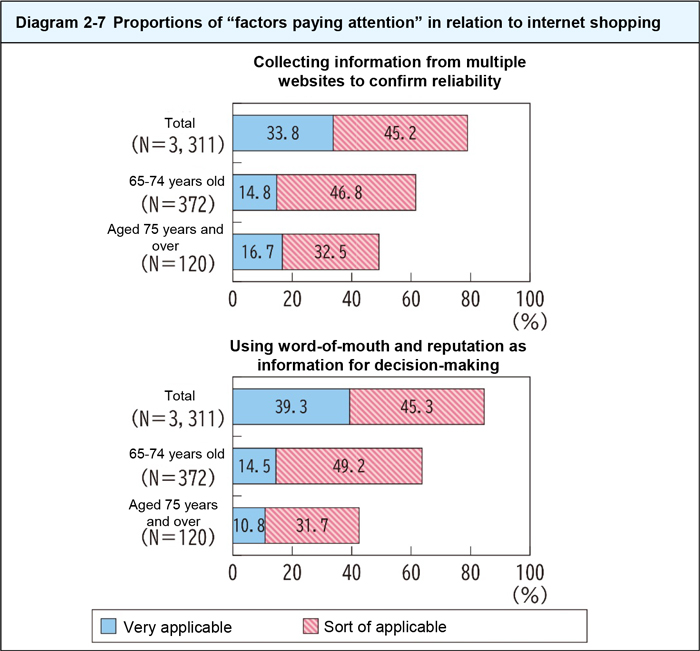
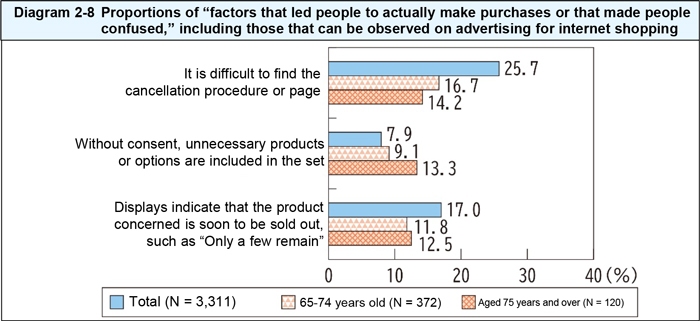
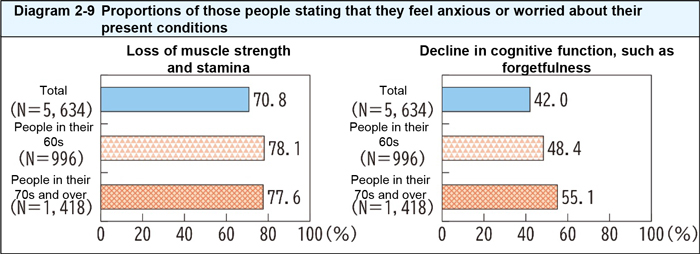
(Note) All the diagrams are created from the "Basic Survey on Consumer Life" (FY2022) of the Consumer Affairs Agency.
<The nature of elderly people in relation to consumer problems>
- The proportion of people who feel anxious about the possibility of encountering consumer problems decreases with age.
- The number of elderly people living alone is increasing, and consumer problems may be less likely to become apparent due to loneliness and isolation.
- The number of elderly people with dementia or other similar conditions is expected to continue increasing. In terms of consumer affairs consultations, the proportion of door-to-door sales and telemarketing sales are characteristically large.
→The nature of elderly people may make them more susceptible to consumer problems.
There are age and individual differences in the vulnerability of elderly people, and there are various different elderly people.
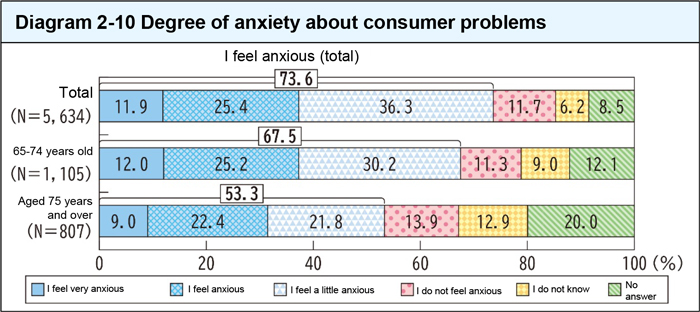
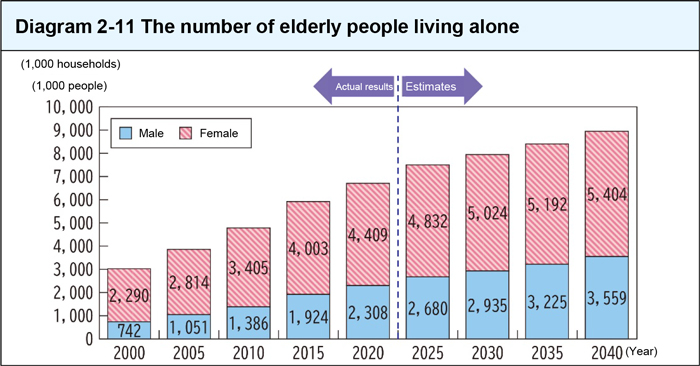
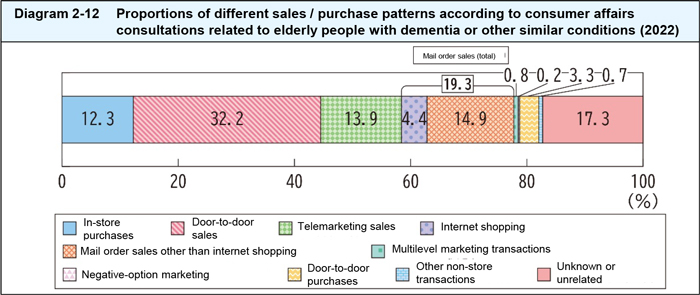
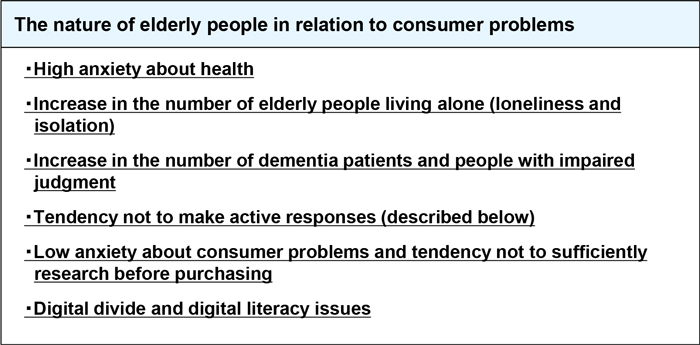
(Note) Diagram 2-10 and lower right side text box: created from the "Basic Survey on Consumer Life" (FY2022) of the Consumer Affairs Agency. Diagram 2-12: created based on information on consumer affairs consultations registered with PIO-NET (as of March 31, 2023).
Diagram 2-11: created from the "Population Census" of the Ministry of Internal Affairs and Communications up to 2020 and from the "Household Projections for Japan: 2015-2040 (2018)" of the National Institute of Population and Social Security Research from 2025 onward.
<Prevention of consumer harm among elderly people ~Responding to a variety of vulnerabilities~>
- When encountering consumer problems, people aged 75 years and over tend not to make active responses such as "making an inquiry to the business or negotiating with the business," while over 60% of them consult with someone close to them.
- Watch-over activities that can respond to situation and vulnerability of each elderly person are effective. A "Local Council for Ensuring the Safety of Consumers" (commonly known as a "Watch-over Network") is established in each local government, and the participation of various local actors including not only administrative organs but also private businesses is encouraged, in order to reinforce the connection of elderly people with people around them in the community.
→Watch-over activities should be carried out in a manner that consumer harm can be prevented or discovered early, so that such activities can provide support for complicated issues involving loneliness and isolation.
→Awareness raising and consumer education that respond to the diverse vulnerability and problem tendencies of elderly people are also needed.
The creation of content for consumer education and information provision aimed for individuals around elderly people and communities of elderly people may potentially enhance the effectiveness of watch-over activities if such content is utilized for watching-over in the community.
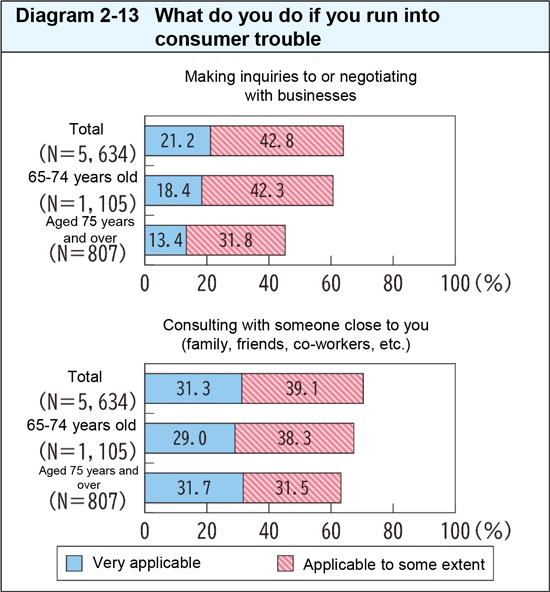
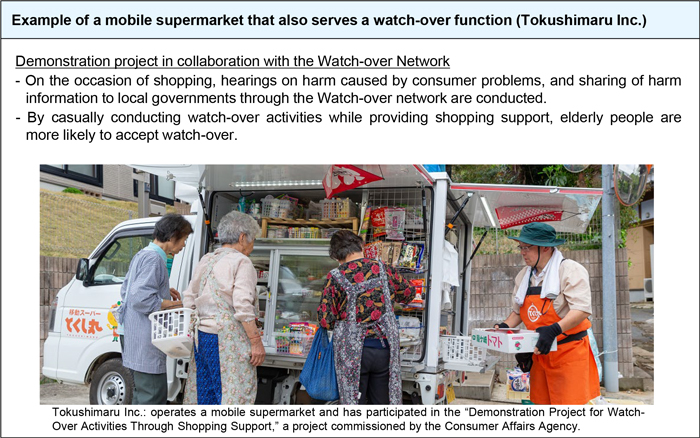
(Note) Created from the "Basic Survey on Consumer Life" (FY2022) of the Consumer Affairs Agency.
<Situation surrounding elderly people's participation in social contribution activities ~"Community" and "the diversity of elderly people"~>
- The percentage of elderly people who participate in social contribution activities is about 16%, which is higher than the percentage of the total population participating in such activities (about 12%). Accordingly, many elderly people take part in community activities.
- "Due to a health-related reason or the lack of confidence in physical fitness," one of the reasons for not participating in social contribution activities despite having an interest in such activities, is characteristically ranked high among elderly people, especially among those aged 75 years and over. Among people aged 65-74 years, those who choose "I do not have enough time to participate or am not emotionally up for participation" mark the highest number.
→In order to promote elderly people's participation in social contribution activities, it is necessary to have a perspective on "local community" and to consider the diversity of elderly people, including their health status.

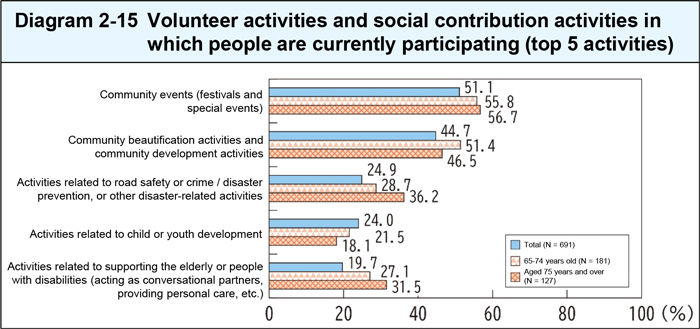
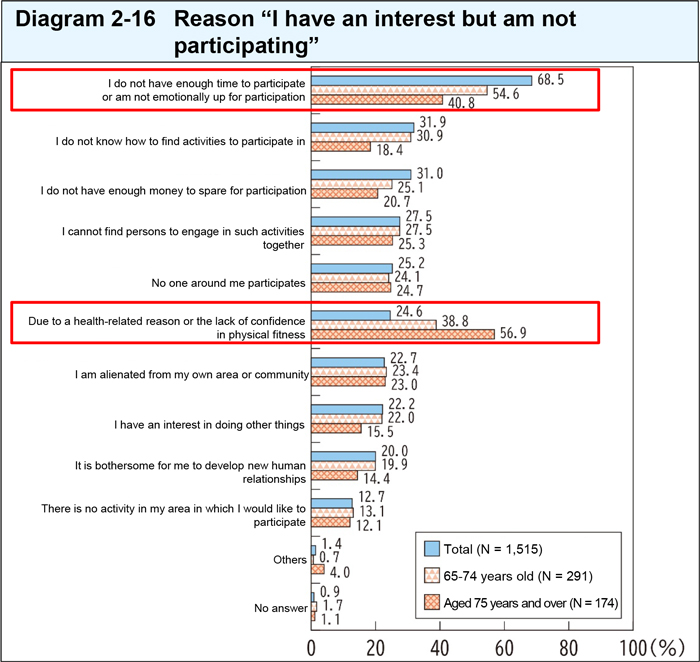
(Note) All the diagrams are created from the "Basic Survey on Consumer Life" (FY2022) of the Consumer Affairs Agency.
<Elderly people's active participation in ethical consumption and further promotion>
- Many elderly people are not familiar with the term ethical consumption (i.e. socially- and environmentally-friendly consumption). On the other hand, they are active on familiar efforts which could lead to ethical consumption.
- With respect to sustainable fashion, elderly people are more active in efforts to make their clothing last longer, compared with the total population in the relevant survey.
With respect to the reduction of food loss and waste, among elderly people, those aged 65-74 years are particularly active.
→If the word and concept of ethical consumption can be spread through consumer education, and if it is recognized that such behavior leads to solutions to environmental and social issues, it is possible that the efforts of the elderly will be further stimulated.
It is also important to promote ethical consumption based on differences in efforts by generation.
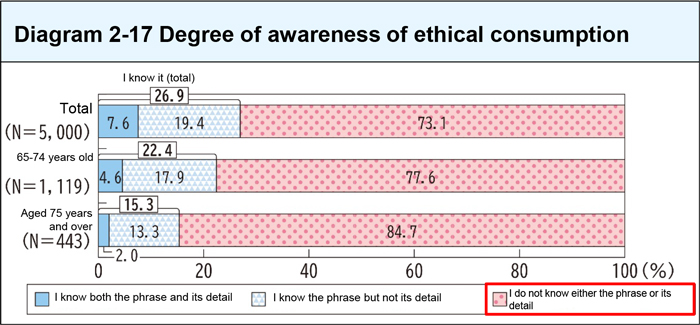
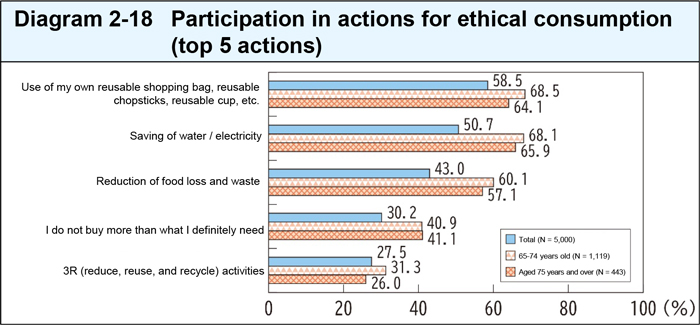
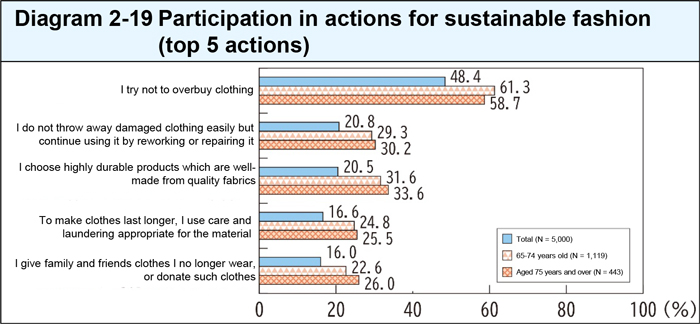
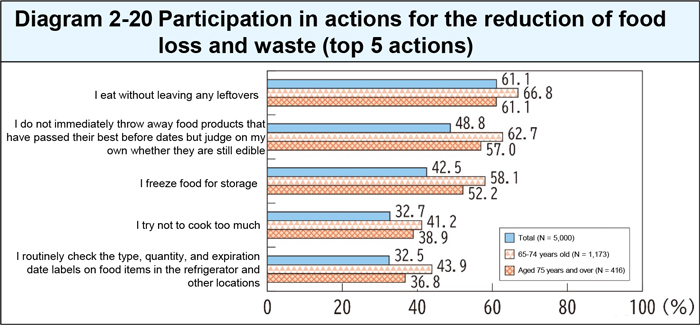
(Note) Diagram 2-17, 2-18, 2-19: created from the "FY2022 Survey on Attitude and Awareness in Consumer Life (Third Survey)" of the Consumer Affairs Agency. Diagram 2-20: created from the "FY2022 Survey on Attitude and Awareness in Consumer Life (Second Survey)" of the Consumer Affairs Agency.
<Promotion of elderly people's participation in social contribution activities (1) ~Various forms of activities~>
[Examples of domestic initiatives]
- Elderly people are highly motivated to contribute to the "community" around them, and the words of appreciation and their bonds with those close to them are rewarding.
- There are also efforts to take advantage of perspectives of elderly people to the improvement of products and services, and to support each other from the same perspective.
→In order to activate social contribution activities by elderly people, it is important to have a familiar "community" perspective and an awareness that there are various ways to engage in social contribution activities.
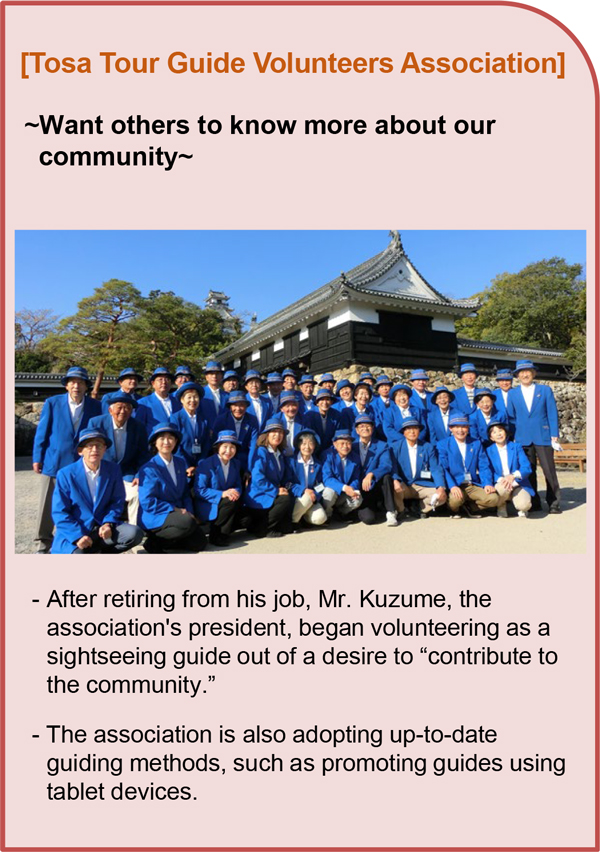
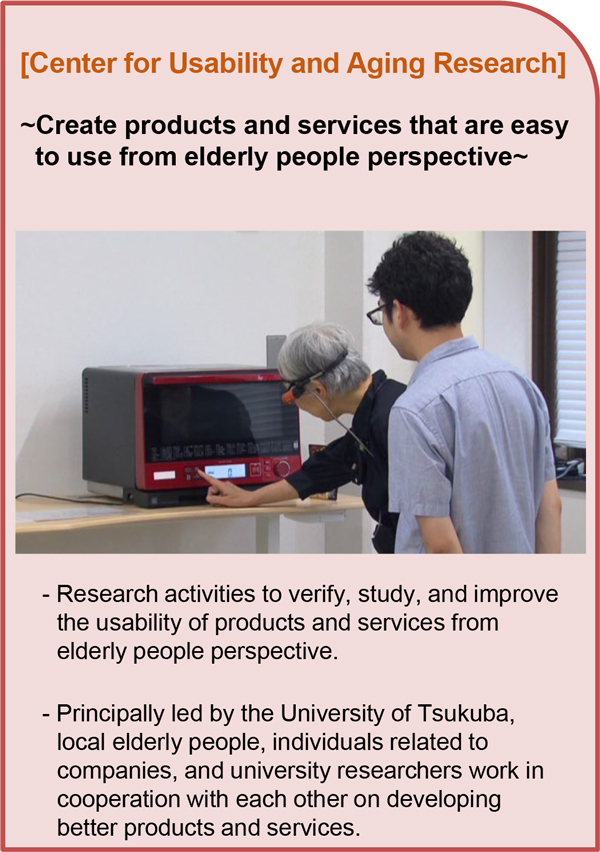
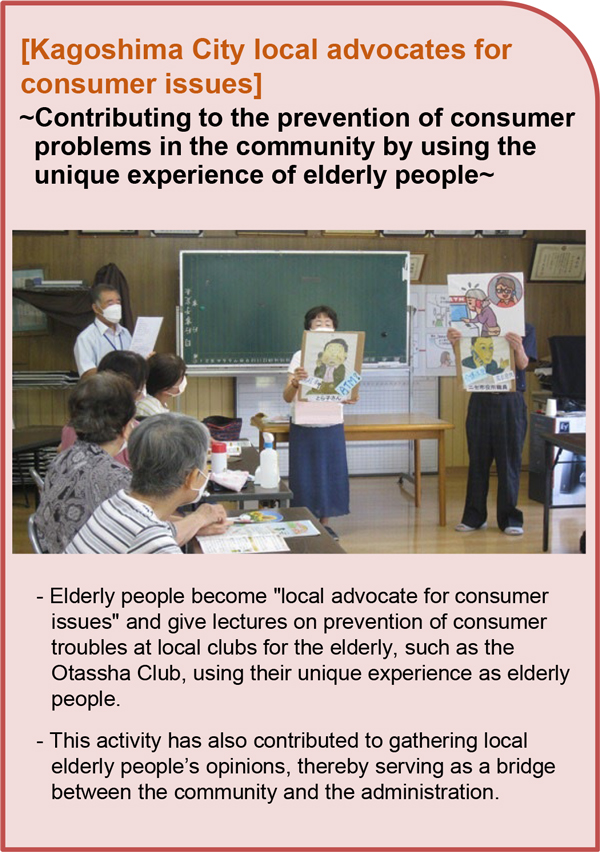
<Promotion of elderly people's participation in social contribution activities (2) ~Initiatives supporting diverse activities~>
[Domestic and overseas support examples]
- Efforts to match social contribution activities with the diversity of elderly people in terms of time, place, skills, paid and unpaid, etc. were observed.
- In overseas countries, there are initiatives that introduce volunteer activities according to the individual qualities of elderly people, or that seek to actively incorporate the viewpoint and knowledge of elderly people into the administration.
→What is required is support adjusted to the diversity of elderly people and the dissemination of information to let people know that such a wide variety of activities is available.
